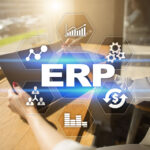Tired of using spreadsheets for your accounting tasks? Sometimes they can have hundreds — if not thousands — of fields where one misstep or mistyped number can send you into a tailspin wondering where you went wrong and how you can reconcile it.
Or maybe you’re frustrated by having all of your accounting functions tied to an older proprietary system that silos data and requires you to manually input or import data you already use elsewhere so you can balance your books.
Accounting is serious business and it’s a core task you should handle with confidence and ease — without worrying about potential errors caused by repeated manual data entries across multiple systems within your company.
Enterprise Resource Planning (ERP) software for accounting can revolutionize the way you access, use and calculate data within your organization for more fiscal responsibility and greater accountability.
Here are a few ways you can use ERP software for accounting so you can focus more on growing your business and less on repeated manual data entries:
All your core data in a single dashboard
There are a lot of moving pieces and parts that go into fiscal accountability. From the costs of supplies and manpower to manufacturing fees and other services, a quality ERP should integrate into most, if not all, of your core operational systems and processes to ensure your team can always access accurate data when they need it.
An ERP can also decrease human error and standardize processes to ensure you have fewer mistakes — and therefore more financial accuracy — for your business.
With a single dashboard, your ERP software can give you instant visibility into all the numbers that keep your business thriving, and in so doing, can help reduce opportunities for fraud or misuse, including user access privileges so you can see who has access to your data and accounts and what they’re doing with them, in near real time.
Integrations for sales, operations and accounting
If your organization hasn’t adopted an ERP to help streamline your operations, you may be frustrated by siloed information that’s entered into one program, for example your sales system, yet never makes it to your accounting system.
Or maybe your accounting solution gets an update with accurate, current prices and information, but your sales solution doesn’t. It’s a flawed system that can mean when it’s time to balance your books, your numbers don’t match up and you have to dedicate valuable time and resources to uncovering discrepancies so you can make sure everything balances in the end.
A quality ERP solution should offer seamless integrations for your existing sales and operational systems into accounting so you can follow your business from sales lead to closed deal and final payment.
Let’s look at this quick example for a hypothetical company:
- A member of your sales team is ready to connect with a sales lead that your marketing team educated and nurtured to the point of a likely product sale.
- Your sales rep can use your ERP, which also integrates into your marketing CRM and CMS platforms, to access the lead’s contact information, find out which product the lead is most interested in, and then quickly and accurately determine cost estimates and review pricing structure. The information the sales rep uses at this stage is the same information available simultaneously for your operations and accounting teams.
- Your sales rep closes the deal! The rep processes the order with an invoice.
- Your new customer pays for the product.
- Your operations team gets instant notification of a new product order and can also see other pending orders.
- Your ERP can help manage product shipping and receiving, again sharing related and valuable information with your accounting team.
- Your team can also use your ERP to track orders, review sales notes, and follow your product through delivery and sales rep follow-up.
- When the process is complete, you can even automate sales commissions and link them directly to product delivery and payments.
Task automation
Looking again at our fictional company and the great job your sales team member did to close a deal, you can also automate a number of tasks directly related to sales and accounting.
Here are a few examples:
- Your sales rep is ready to create an invoice to obtain product payment. There are likely a number of parameters for accounting your sales rep should include in this process. Your ERP can automate and standardize these tasks; for example, it can address whether or not this deal requires a purchase order (PO) number, if the client has any credit limits or concerns, if the customer qualifies for any discounts, and handle any relevant tax information.
- If there are issues, your accounting team can instantly share that information with your sales team for customer follow up.
- Your sales team can even make cost estimates based on the most recent purchasing activity to ensure the information your accounting team sees is accurate.
Here are some other accounting tasks an ERP can automate so you can save time and free up your staff to focus on more pressing issues:
- Generate invoices
- Progress billing
- Subscription information
- Services rendered
- Purchase orders
- Close orders when products are delivered and payment received
- Stopping product delivery if there is a payment issue
- Set up and run recurring transactions based either on a schedule or specified amount
Multiple locations, multiple departments, multiple budgets
If your organization has multiple departments, it’s likely you have to manage and account for a variety of budget types. With an ERP, you can immediately access, track, and change budget-related information, not just departmentally, but even across multiple locations or entities within your operations. You can also use your ERP to plan for, manage, and maintain budgets for multiple product lines or business units within our organization — all within one platform.
Payment integrations
Tired of repeatedly inputting the same payment information into multiple systems within your company? A good ERP solution should also include fully integrated payment processing. Look for a solution that is PCI compliant for credit cards, debit cards, and ACH payment processing.
Reports and analytics
Whether you’re conducting an internal audit or you’re required to meet mandated compliance and regulation audits, ERP software makes preparing for audits a breeze. Your ERP should help your team access the data you need quickly and generate reports and other analytics that make it easy for you to communicate information in a digestible format for all your key stakeholders. Your ERP should come with great out-of-the box reports, but also offer customizations that your team can configure to meet all of your key needs.
Increased visibility
Your ERP should be a true quote-to-cash solution that increases visibility into your organization’s financial health — from the big picture down to a granular level — so you can save time, reduce errors, and have accurate insight into the financial components of your operations at all times.
Are you ready to see how aACE’s ERP solution for accounting can help you with intuitive reporting, budget forecasting, sales tax calculation, payment processing and a whole lot more? Contact us to learn more.
“[I would recommend aACE to] any company that needs a seemingly impossible-to-achieve customized accounting system that will take them from inputting a transaction to the general ledger.” – Wendy Donenfield, CPA and Controller, M & R International




